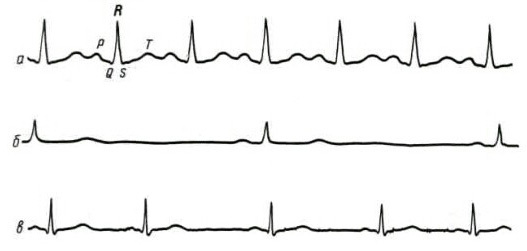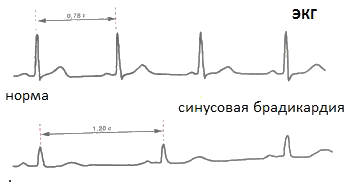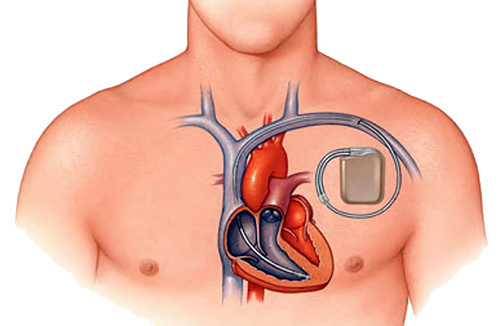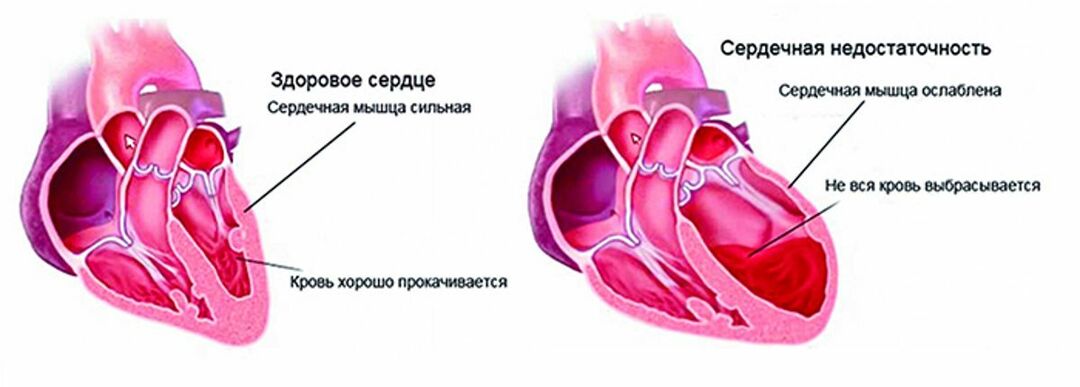Bradycardia - variants of norm and pathology
Heart rate indicators that show the heart rate allow you to assess the state of the cardiovascular system and draw preliminary conclusions about the violations in its activity. The number of heartbeats is not constant. It depends on such factors as age, time of day, ambient temperature, body fitness, health status, etc.
In children, pulse rates change every 1-2 years, and, from 15 years to 50 years, the frequency of contractions isAbout 60-80 beats per minute. Since the age of 50, especially in people who have a low-activity lifestyle, the heart is aging and the pulse is increasing. Normally, its indicators for people 50-60 years old are 64-84 ud. Per minute, and after 60 - 69-89 ud.in a minute.
Under the influence of various factors, the pulse can:
- increase( tachycardia) - more than 80 beats. Per minute( Figure 1 a);
- slow down( bradycardia) - less than 60 ud. Per minute( Figure 1 b).

Fig.1 - Sinus rhythm disturbances: a - sinus tachycardia( 110 cuts per minute);B - sharp sinus bradycardia( 34 contractions per minute);C - sinus arrhythmia( there is a different duration of cardiac complexes( 0.70 s, 0.94 s, 0.82 s, 0.68 s)).
Given the dependence of these indicators on many internal and external factors, a person who does not have medical education can not independently properly assess the situation, accompanied by the appearance of heart rate slowdown, and that is why attempts at self-diagnosis or treatment of bradycardia are not recommended and can be dangerous.
In this article we will acquaint you with the causes, varieties, variants of the norm and pathology, ways of diagnosing and treating this type of heart rate deviation from the norm indicators like bradycardia.
Content
- 1 Causes and bradycardia classification - variants of norm and pathology
- 1.1 physiological bradycardia
- 1.2 Pathological bradycardia
- 2 Symptoms
- 3 Diagnostics
- 4 Treatment
- 4.1 Drug therapy
- 4.2 Surgery
Causes and bradycardia classification - variants of norm and pathology
InDepending on the localization of the violations revealed in the heart, the disorders are different:
- sinus bradycardia - slowing of the pulse is caused by disorders of aAutomaticity in the sinus node;
- bradycardia with atrioventricular( AV) or sinoatrial( CA) blockade of the heart - slowing of the pulse is caused by impaired conduction of the pulse between the sinus node and atria and ventricles or atria.
Depending on the causes of development, these types of sinus bradycardia are distinguished:
- sinus bradycardia of athletes - develops in physically trained people;
- extracardiac( or neurogenic) - develops with neuroses with autonomic dysfunction, neurocirculatory dystonia, peptic ulcer, increased intracranial pressure, hypothyroidism, myxedema, physical effects on the carotid sinus or eyeballs;
- drug - develops with prolonged or incorrect intake of certain drugs;
- organic - is caused by cardiac pathologies( myocardial infarction, myocarditis, cardiosclerosis, microcardiostrophy);
- toxic - develops with severe intoxication, provoked by toxic substances or infections;
- idiopathic - develops due to unclear reasons.
Bradycardia can be:
- physiological - slowing of the pulse is caused by external causes, this kind of bradycardia is a variant of the norm, because the decrease in the heart rate is due to physiological causes;
- pathological - slowing the pulse can be acute or chronic, caused by the impact of internal or external pathological factors.
Physiological bradycardia
The reasons for the development of physiological bradycardia are such factors:
- Age. Bradycardia is caused by age-related changes in the myocardium( cardiosclerosis), which, as a rule, occur after 60-65 years and lead to the fact that heart contractility becomes worse and changes take place in the conduction system, leading to slowing of the pulse at rest.
- Good physical preparation. Slowing down the pulse is the result of frequent physical exertion, which many professional athletes experience. They lead to the fact that the heart muscle is able to contract more strongly than an ordinary person and maintains normal blood circulation even with a slow heart rhythm. This is because systematic training leads to the appearance of additional muscle fibers in the myocardium. With such a decrease in the pulse to 45-50 ud. Per minute, a person continues to feel normal and has no signs of a disturbance of normal hemodynamics. This kind of bradycardia is usually observed in athletes( for example, football players, runners, swimmers, cyclists, etc.), who during the training experience for a long period of physical activity of moderate severity.
- Moderate supercooling( hypothermia).Slowing the pulse is caused by a complex cooling of the body, which is accompanied by a decrease in body temperature to 35 ° C or less. In such cases, slowing of the heart rate is a protective mechanism that occurs in response to an unfavorable factor. That is, the heart turns to the "economic regime" in order not to exhaust the necessary energy resources. After normalizing the temperature, the indicators come back to normal.
- Stimulation of reflex zones. Slowing down the pulse can occur artificially( i.e., reflex) when stimulating the vagus nerve. Such a reflex reaction can be provoked by a slight pressure on the eyeballs or a carotid sinus massage( the site of branching of the carotid artery).
- Idiopathic bradycardia. This kind of bradycardia can manifest itself both constantly and periodically. It is not possible to establish the cause of such heart rate slowdowns even with a comprehensive medical examination. If, in addition to slowing the pulse in a person, there are no signs of hemodynamic disturbances, such a slowing of the pulse is considered physiological and does not require treatment.
Pathological bradycardia
The causes of the development of pathological bradycardia are such factors:
- Heart pathology. Heart diseases lead to the appearance of sclerosed sites in the myocardium and / or inflammatory processes that disrupt the functioning of the conductive system and cause bradycardia. Slowing of the pulse can be observed with such heart pathologies: focal or diffuse cardiosclerosis, IHD, myocardial infarction, infectious diseases( myocarditis, endocarditis).
- Infections. Most infections cause tachycardia, but some infectious diseases can help slow the heart rate. They include: severe forms of sepsis, certain variants of the course of viral hepatitis, typhoid fever.
- Hypothyroidism. When hypothyroidism occurs, the level of thyroid hormones decreases, which affect many physiological processes occurring in the body, including metabolism. One of the signs of their insufficient number is the disruption of the functioning of the nervous system and the heart, which are manifested by a slowing of the pulse. To lead to the development of hypothyroidism can such pathologies: thyroiditis, congenital hypo- or aplasia of the thyroid gland, poisoning with toxic isotopes of iodine, transferred traumas or surgical interventions on the thyroid gland, autoimmune thyroiditis, some infectious diseases.
- Increased parasympathetic nervous system tone. Parasympathetic innervation of the heart is carried out through the branches of the vagus nerve, and with a pathological increase in its tone, there will be a slowing of the heartbeats. Such a decrease in the pulse may be caused by such diseases and conditions: craniocerebral trauma, mediastinal neoplasms, hemorrhagic stroke, neuroses, depression, increased intracranial pressure, peptic ulcer, surgical operations in the mediastinum, head or neck area.
- Poisoning. Slowing the pulse can be a sign of poisoning with such toxic substances: nicotine, lead compounds, some narcotic drugs, pesticides and organic phosphorus compounds. As a rule, in case of poisoning, the slowing down of the pulse develops rapidly, and the severity of the bradycardia depends on the number of poisonous compounds that have entered the body.
- Accepting a number of medicines. Bradycardia can be a side effect or a sign of poisoning by certain medications. As a rule, such a decrease in the pulse is temporary and does not threaten life or health, but with frequent episodes of bradycardia it is still recommended to see a doctor to adjust the dosage or change the drug. In most cases, the cause of heart rate slowdown is incorrect dosing or violation of the rules of admission. The most pronounced episodes of bradycardia can be caused by the use of such drugs: calcium channel blockers, cardiac glycosides, beta-blockers, Morphine, Digitalis, Adenosine, Quinidine, Amisulpride.
Symptoms of
Physiological or moderately pronounced bradycardia in most cases is not accompanied by violations of normal circulation and is asymptomatic. The appearance of signs of slowing of heart contractions is usually observed in pathological bradycardia, in which the slowing of the pulse is less than 40 beats.in a minute. In such cases, the patient has the following symptoms of hemodynamic disorders:
- general weakness;
- darkening in eyes and flickering of "midges" before eyes;
- fast fatigue;
- cold sweat;
- dizziness;
- is a pre-fainting or fainting condition.
Do not delay the visit to the doctor, because the following dangerous conditions can become the consequences of pathological bradycardia:
- Morgagni-Edams-Stokes syndrome( periodic episodes of loss of consciousness);
- unstable blood pressure or hypertension;
- IHD;
- angina;
- chronic circulatory failure.
Diagnosis
To clarify the diagnosis, a patient with bradycardia may be assigned such diagnostic examination methods:

- listening to heart tones with a stethophonendoscope;
- analysis of ECG at rest and veloergometry;
- holter monitoring of ECG;
- Echocardiography;
- clinical and biochemical analyzes of urine and blood;
- transesophageal electrophysiological study of the conductive ways of the heart( if cardiac blockades can not be detected with ECG);
- bacteriological analysis of blood or urine( with suspected infectious disease);
- analysis for toxins( if suspected of being poisoned).
Treatment
The decision on the need for treatment of bradycardia is taken individually, taking into account the characteristics of the patient's symptoms and depending on the results of the survey.
Treatment of the physiological form of the disease or bradycardia with a slight slowing of the rhythm of the heart and the absence of signs of circulatory disorders is not carried out. In such cases, the patient is recommended to have cardiac examinations, individual selection of physical activity, walking outdoors, rational organization of work and rest, control of blood pressure and pulse and compliance with the rules of rational nutrition( restriction of animal fats and salt).
In case of drug bradycardia, correction of previously prescribed treatment is performed - dosage modification or drug cancellation.
In other cases, the patient is prescribed therapy for the underlying disease, which led to a slowing of the pulse. Indications for the appointment of medical or surgical treatment of bradycardia are such conditions and pathologies:
- dizziness and fainting;
- frequent episodes of bradycardia, causing uncomfortable symptoms or disability;
- reduction in heart rate to less than 40 beats.in a minute;
- chronic pathologies that cause bradycardia;
- hypotension.
Drug therapy
When such symptoms of bradycardia as weakness and dizziness are recommended, taking medications to stabilize the rhythm of the heart:
- preparations based on belladonna, eleutherococcus or ginseng root;
- Isoprenaline;
- Isadrin;
- Atropine;
- Eufillin;
- Caffeine, etc.
These medicines may only be prescribed by a doctor who can correctly choose the dosage. As a rule, they are taken during an episode of a bradycardia, but in some cases therapy is carried out by courses( weeks or months).
In addition, the patient is prescribed medicines for the treatment of the underlying disease that caused a slowing of the heart rate( antibiotics, thyroid hormones, preparations for the treatment of angina pectoris, etc.).
Surgical treatment of
In a number of cases, only surgical treatment can be used to eliminate bradycardia:
- operations for the implantation of a pacemaker( Figure 3);
- surgery to remove tumors of the mediastinum.

Fig.3 - Pacemaker installation diagram.
Indications for pacemaker implantation:
- acquired AV blockade II B-III degree with circulatory failure of III-IV degree or with episodes of attacks of Morgagni-Adams-Stokes;
- AV-blockade II B-III degree, occurring 3-4 weeks after an attack of myocardial infarction and unchangeable;
- syndrome of sinus node weakness with episodes of Morgagni-Adams-Stokes attacks or with circulatory failure of grade III-IV;
- bradyarrhythmia of flicker or atrial flutter with a pulse rate of less than 50 beats.in a minute.
Relative indications for pacemaker implantation:
- congenital form of complete AV blockade in adults with circulatory failure of grade III;
- chronic tri- or bifascic block;
- extension of the QRS complex is more than 0.8 s and an increase in the HV interval of more than 100 ms;
- is a congenital form of AV blockade with circulatory failure of III-IV degree or weakness of the sinus node with episodes of Morgagni-Adams-Stokes attacks.
The model of the pacemaker is selected individually, depending on the causes that caused the bradycardia, and the degree of hemodynamic disorders.
Cardiologist Petrova Yu.
Recommended for viewing:



